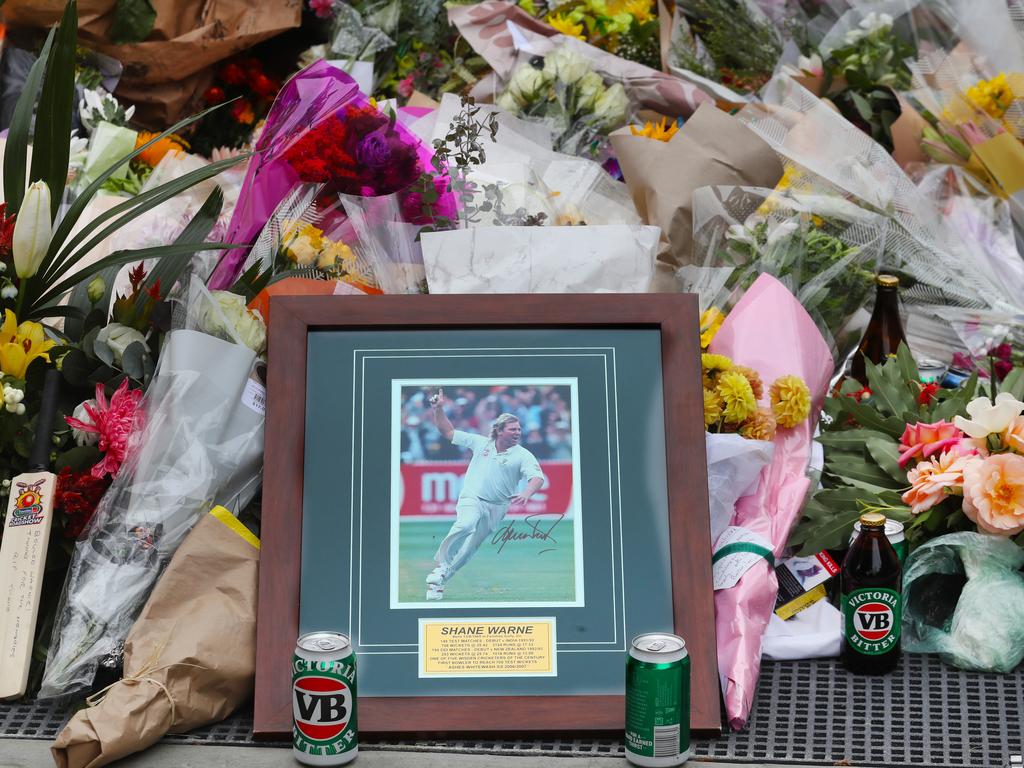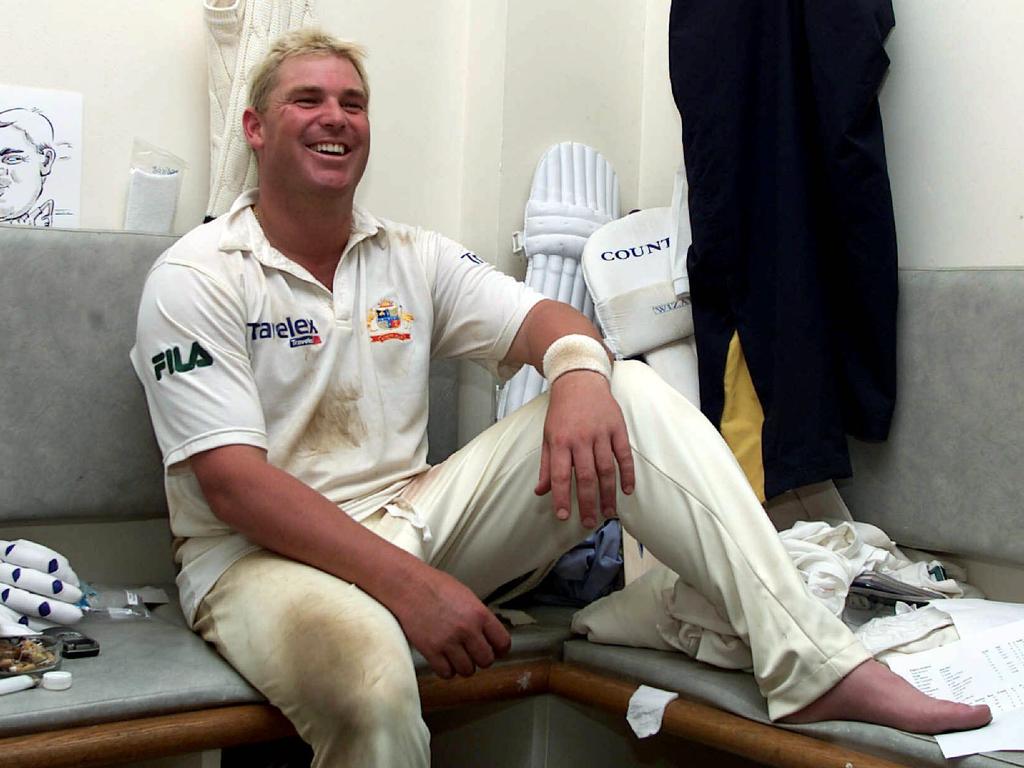
I cannot think that I have ever been more shocked than when, thousands of miles over the Atlantic, on the way to Antigua, the photographer Phil Brown walked down the aisle of the aircraft to say, simply: “Warne is dead.” What? Brown’s eyes were red, so I knew it was true but it is impossible even now to believe that someone so vital, so full of energy, so fizzing with the enjoyment of life’s rich possibilities, could be dead at the age of 52 after suffering a suspected heart attack.
Having played against him for almost a decade, and having worked alongside him as a commentator for longer, I knew him very well. But everyone knew him well because his character radiated from every minute of cricket he played. It is a cliche that sport reveals character, but never was that truer than with Warne. You knew, watching him play, that he was a chancer, an adventurer, a gambler; someone who was street smart and intelligent - not in an academic sense, mind you - with a slightly reckless streak. He was all that, and more. What a player; what a life.

Warne, it can be said without fear of contradiction, was the greatest leg spinner in the history of the game, and one of its greatest cricketers in the round. In 2000, he was voted one of Wisden’s cricketers of the 20th century with no murmur of dissent. He did not look out of place alongside other luminaries such as Donald Bradman and Garry Sobers. More than that, he would not have felt himself out of place. He probably thought he should captain the side, to make up for never having been a tenured captain of Australia - one of the game’s great misses.
There are three common attributes that unite great cricketers, in my experience: high levels of talent and skill; an unquenchable competitive spirit and never-say-die approach; and total self-belief - or at least the ability to bluff others about that self-belief. Who knows, deep down, whether these champions have their dark moments of the soul when self-doubt gnaws away at them, but if they do they are usually well hidden.
Warne was blessed with all those attributes. Through hard graft, he perfected the most difficult of all cricketing art forms, combining the accuracy usually given to finger spinners, with the added guile and mystery and attacking instincts of the wrist spinner. His competitiveness was never more to the fore, incongruously, in the one Ashes series he lost, in 2005, when he stood tall in defeat with bat and ball. And self- belief? Well, he would throw himself brazenly into any situation on or off the field, embarrassment be damned.
The fierce heat and hard pitches of Australia have traditionally made it the land of the wrist spinner, but the art was in decline when Warne was first picked for the national team under Allan Border, neglected on the altar of the fast-bowling heroes of the 1970s, Dennis Lillee and Jeff Thomson. Temperamentally, Warne had a fast bowler’s outlook and Lillee was a hero of his as he grew up in the suburbs of Melbourne. Both now share the forecourt of the Melbourne Cricket Ground, immortalised in bronze.
Australian rules football was Warne’s first love - a sport to which he remained addicted - and played to a high standard. It is a game that demands high levels of fitness and strength and Warne was blessed with some natural physical attributes that helped his progress in cricket too. If you had ever shaken his right hand you would know what I mean: his grasp was strong and firm and allowed him to wrap his fingers around the ball and give it a good tweak.
He was hot-headed, a trait that led to him being turfed out of the Australian Cricket Academy as a young man, but he was ambitious and intelligent enough to know not to waste his talent and he found a mentor in Terry Jenner, another with a rebellious streak. He would tell the story of how, having been kicked out of the academy, he drove to Jenner’s with a crate of beer, knocked on the door only to get lectured by Jenner about the need to take his cricket seriously, which he eventually began to do. Jenner was there for him throughout his career.
Never underestimate the hard work required to become a great cricketer - there are no shortcuts. Hours in the nets followed, landing the ball on a patch the size of a handkerchief; sore and blistered fingers, damaged shoulder rotator cuffs. He began to master the essentials: the hard-spun leg break, his stock ball; the googly, bowled out of the back of the hand; the top spinner, and flipper, flicked from underneath, the ball squeezed from thumb and forefinger, followed by the slider, pushed from the front of the hand, when he lost the ability to land his flipper. He perfected them all.

Alongside that was a level of cricketing intelligence, the trait that set him apart, I felt, from the other great spinner of the day, Muttiah Muralitharan. As with Warne, Muralitharan was a great spinner, someone who could fizz the ball and turn it on ice because of a freakish set of attributes. But given a cricketing puzzle, Warne had a greater ability to outthink a batsman: the only time I saw him run up the white flag was against Kevin Pietersen in Adelaide, when he bowled so far outside leg stump for a period as to admit defeat. He was the cleverest bowler I played against, without doubt, always probing, always looking to move the game forward.
When he landed in England for his first Ashes series in 1993, we hadn’t seen that much of him. His early Tests had been unremarkable and at the start of the tour he had been taken to the cleaners by Graeme Hick in a match at Worcester. Border, the Australia captain, had instructed Warne not to show any of his tricks in that match and there was no way the heavy rain at Old Trafford was going to encourage Border to play Tim May, the finger spinner instead, as so many pundits were urging.
The rest is history. Warne’s first ball in Ashes cricket was sent fizzing towards Mike Gatting, a fine and experienced player of spin; it swerved in the air, as a consequence of the amount of sidespin and overspin on the ball; it dipped a fraction too, and Gatting, groping blindly, was totally deceived. That another great leg spinner, Richie Benaud, was on hand to provide the commentary added to the moment. “Still doesn’t know what happened,” Benaud deadpanned as Gatting walked off bemused, like a bear, one scribe wrote on the day, who had had his porridge whipped from under his nose.
In that moment Warne became a cricketing superstar and that’s how things were to remain throughout his career. His time coincided with the rise of satellite television and so earnings, endorsements and attention came to him in a way that previous generations of Australian cricketers (Bradman apart) could only dream of. It is the curse that great sportsmen have to deal with adoration, fame and wealth long before they are fully matured and Warne did not always handle the attention with grace. There were stumbles along the way.
There were bad times - a ban for taking a diuretic, a rap over the knuckles for poor onfield behaviour in South Africa, and plenty of tales to keep the tabloids in print - but he did not have a bad streak. He was often surrounded by the monied, as great sportsmen always are, but I was impressed by the way he interacted with those that others might brush off. Warne greeted “ordinary folk” as he would anyone else. There were no airs about him - as his favourite meals of cheeseburgers, chips and pizza would attest.
It was the greatest honour of my cricketing life to have played against a team commonly regarded as among the best three to have graced the cricket field. And among that champion team, Warne stood head and shoulders above the rest. What a sense of theatre he had, never better demonstrated in general than in the way he forced the pace of the game to bend to his rhythm with ball in hand and, to take a specific example, when he took his 700th Test wicket on Boxing Day at his beloved MCG.
The last time we messaged was about a young cricketer in the London Spirit franchise, about whom I’d asked his opinion. “Terrific young guy,” he replied, “and I would say he has a good chance to play for England in three years. Impressive!” A typical Warne reply: upbeat, energetic, optimistic. And probably, where cricketing matters are concerned, right.
The Times








Can it be true? Such a force of nature, taken in his prime? That Shane Warne lived his life to the full, fitting more in one year than many others would have incorporated into a lifetime, is no consolation. Really, in a week in which Rod Marsh, another giant of Australia cricket, also died, this is too much to bear.